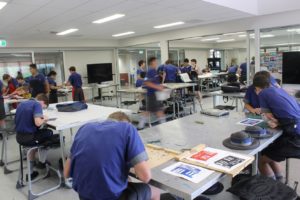Does the investment in space make a difference?

In this post by ILETC Research Fellow, Terry Byers, discusses moving the focus from design of learning spaces to impact on teaching and learning…
The form and function of what constitutes an effective learning environment is undergoing significant exploration at present. Many have highlighted the potential of ’21st Century’, ‘flexible’ and ‘innovative’ spaces to shape behaviour and experiences to affect a desired pedagogical change. The resulting ‘building binge’ has led to the construction of extravagant architectural and aesthetically pleasing spaces. Much is written about the potential of the architecture and technologies (both digital and spatial) to facilitate the likely paradigm change to learning. Despite considerable investment in innovative learning environments and architectural awards, there is limited evidence of exactly how the desired learning occurs, let alone the resulting impact on student engagement and academic outcomes.
Over the past six years, the Anglican Church Grammar School (Churchie) in partnership with the University of Melbourne’s Learning Environments Applied Research Network (LEaRN) has focused on addressing this lack of evidence through the New Generation Learning Spaces (NGLS) project. This work within the Australian Research Council Linkage project Evaluating 21st Century Learning Environments (E21LE) evaluated the impact of different spatial layouts through a series of modest interventions.
The partnership devised an approach and tools that isolated the impact of different learning spaces on teaching and learning. Across a series of spatial interventions, it was found, time and time again, that different classroom layouts accounted for at least 7 % of the variation in academic outcomes in English, Humanities, and Mathematics (when the variables of cognitive ability, class composition and the teacher are mediated) (for detailed results, see Byers & Imms, 2016; Byers, Imms, & Hartnell-Young, 2014).

Anglican Church Grammar School, Brisbane. Art Studios.
The empirical evaluation of these early interventions identified the unexpected role of a teacher’s ‘environmental competency’ as a key mediating variable in the impact of any learning environment. Developed by Lackney (2008), the concept of environmental competency focuses on the ability of a teacher to utilise the affordances of the physical learning environment with their practices for pedagogical gain. To better understand the influence of environment competency on the pedagogical performance of any learning environment, the partnership developed, trialed, and evaluated the real-time ‘Linking Pedagogy, Technology, and Space’ (LPTS) observational metric. The metric provides instantaneous visual quantitative feedback to teachers on their practice and the subsequent impact on the activity and behaviour of their students. When applied through a longitudinal approach, the quantitative analysis of data from the LPTS metric can ascertain the pedagogical impact of an innovative learning environment.
This novel approach was applied to the in-situ longitudinal evaluation of Churchie’s Hayward Midson Creative Precinct (pictured) designed by Brisbane architectural firm Brand + Slater Architects. The Precinct brought together the Creative Arts (Drama, Film, Television and New Media, and Visual Art) and Design and Technology (Engineering, Design and Technology, and Technology Studies) into one pedagogical space. Over a two-year period, the LPTS metric provided real-time feedback through more than 120 observations. The feedback to each teacher ascertained how their practice evolved throughout the spatial transition. As the understanding of their impact grew, so did their environmental competency.
The partnership between Churchie and LEaRN has provided empirical evidence of the pedagogical return of innovative learning environments. Rather than hypothetical musings, this evidence-informed approach has supported teachers to develop their environmental competency to work in new ways within these innovative spaces. More importantly, this evidence provided a novel post-occupancy feedback mechanism, not only to teachers but to architects and designers, which has influenced future building projects at Churchie.
Terry Byers is a Research Fellow on the ILETC project and Director of Innovation in Learning at the Anglican Church Grammar School (Churchie) in Brisbane, Queensland.
Reference List
- Byers, T., & Imms, W. (2016). Does the space make a difference? Empirical retrospective of the impact of the physical learning environment on teaching and learning evaluated by the New Generation Learning Spaces Project. Brisbane, Queensland: The Anglican Church Grammar School.
- Byers, T., Imms, W., & Hartnell-Young, E. (2014). Making the case for space: The effect of learning spaces on teaching and learning. Curriculum and Teaching, 29(1), 5-19. doi:10.7459/ct/29.1.02
- Lackney, J. A. (2008). Teacher environmental competence in elementary school environments. Children, Youth and Environments, 18(2), 133-159. doi:www.colorado.edu/journals/cye



